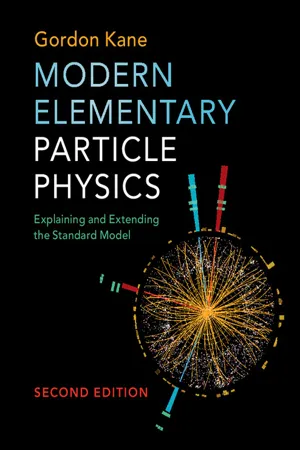
Modern Elementary Particle Physics
Explaining and Extending the Standard Model
- English
- PDF
- Available on iOS & Android
About this book
This book is written for students and scientists wanting to learn about the Standard Model of particle physics. Only an introductory course knowledge about quantum theory is needed. The text provides a pedagogical description of the theory, and incorporates the recent Higgs boson and top quark discoveries. With its clear and engaging style, this new edition retains its essential simplicity. Long and detailed calculations are replaced by simple approximate ones. It includes introductions to accelerators, colliders, and detectors, and several main experimental tests of the Standard Model are explained. Descriptions of some well-motivated extensions of the Standard Model prepare the reader for new developments. It emphasizes the concepts of gauge theories and Higgs physics, electroweak unification and symmetry breaking, and how force strengths vary with energy, providing a solid foundation for those working in the field, and for those who simply want to learn about the Standard Model.
Frequently asked questions
- Essential is ideal for learners and professionals who enjoy exploring a wide range of subjects. Access the Essential Library with 800,000+ trusted titles and best-sellers across business, personal growth, and the humanities. Includes unlimited reading time and Standard Read Aloud voice.
- Complete: Perfect for advanced learners and researchers needing full, unrestricted access. Unlock 1.4M+ books across hundreds of subjects, including academic and specialized titles. The Complete Plan also includes advanced features like Premium Read Aloud and Research Assistant.
Please note we cannot support devices running on iOS 13 and Android 7 or earlier. Learn more about using the app.
Information
Table of contents
- Cover
- Half-title
- Title page
- Copyright information
- Contents
- Preface
- 1 Introduction
- 2 Relativistic Notation, Lagrangians, and Interactions
- 3 Gauge Invariance
- 4 Non-Abelian Gauge Theories
- 5 Dirac Notation for Spin
- 6 The Standard Model Lagrangian
- 7 The Electroweak Theory and Quantum Chromodynamics
- 8 Masses and the Higgs Mechanism
- 9 Cross Sections, Decay Widths, and Lifetimes; W and Z Decays
- 10 Production and Properties of W[sup(pm)] and Z[sup(0)]
- 11 Measurement of Electroweak and QCD Parameters; the Muon Lifetime
- 12 Accelerators – Present and Future
- 13 Experiments and Detectors
- 14 Low Energy and Non-Accelerator Experiments
- 15 Observation of the Higgs Boson at the CERN LHC; is it the Higgs Boson?
- 16 Colliders and Tests of the Standard Model; Particles are Point-Like
- 17 Quarks and Gluons, Confinement and Jets
- 18 Hadrons, Heavy Quarks, and Strong Isospin Invariance
- 19 Coupling Strengths Depend on Momentum Transfer and on Virtual Particles
- 20 Quark (and Lepton) Mixing Angles
- 21 CP Violation
- 22 Overview of Physics Beyond the Standard Model
- 23 Grand Unification
- 24 Neutrino Masses
- 25 Dark Matter
- 26 Supersymmetry
- Appendix A Angular Momentum and Spin and SU(2)
- Appendix B Some Group Theory
- Appendix C Some Relativistic Kinematics
- Appendix D The Point-Like Cross Section
- Appendix E When Are Our Approximations Not Valid?
- Appendix F Lagrangians and Symmetries; the Euler–Lagrange Equations and Maxwell's Equations
- Index